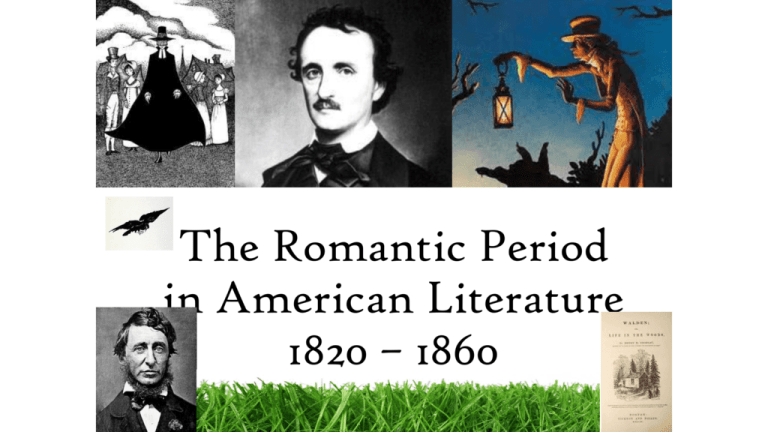PoeIntro
advertisement

The Romantic Period in American Literature 1820 – 1860 Two kinds of Romantics • Dark Romantics: Characters were haunted, alienated individuals; mood: dark and foreboding; themes: exploration of the hidden recesses of the soul; motifs: nature is dangerous, forbidden; fascination with the supernatural • Transcendental Romantics: In tune with the optimism of the growing nation; valued the beauty of nature, solitude, nonconformity, and the individual Edgar Allan Poe (1809 – 1849) • Legends and untruths • Troubled childhood • Father left; mother died; taken in by the Allan family • • • • College, gambling problems, and family turmoil 1827 – publishes Tamerlane and Other Poems Expelled from school Barely supports self as magazine editor in New York, Baltimore, Richmond • Lived in poverty despite success of “The Raven” and short stories • Depression, madness Poe’s mysterious death • Wife Virginia died at 24; Poe died two years later • No one really knows how Poe died, though there are many theories • On his way to Philadelphia to edit a book of poetry, Poe fell ill and was taken to the hospital; he was unconscious and dressed in strange clothing; he died days later Quoth the Raven “Nevermore.” Poe’s stories and poetry • Regarded as brilliant, original • Exploration of the dark side of human nature: wickedness, death, guilt, revenge, fear • “The Cask of Amontillado,” “The Tell-Tale Heart,” “The Raven,” and “Annabel Lee” • Altered American literature • Gothic literature: bleak, remote settings; violent incidents; characters in psychological torment; supernatural elements; strong language with dangerous meanings • Poe’s “single effect”: fear and disturbing ambiguity about what is real Reading Poe • Break down long sentences/paraphrase – Poe uses long sentences, ornate diction, and detailed descriptions, which all contribute to the “single effect” of his story. Pause to make sure you understand, and re-read if needed. Read once for basic understanding, twice to clarify, and a third time to analyze. • Pause to annotate, summarize, and interpret. “The Cask of Amontillado” • Catacombs – much of the action of the story takes place in the catacombs of Italy; these are underground tunnels often beneath family homes used to bury the dead; • Amontillado – a kind of wine • Carnival – an Italian festival dating back centuries that involves revelers wearing masks, day and night celebrations Irony – a contradiction between appearance and reality • This story relies heavily on irony for its creepiness. • Situational – when something happens that contradicts the expectations of the reader or a character; when the events are ironic • Dramatic – when a character’s understanding is substantially different from the audience’s understanding • Verbal – when what someone says in ironic • Irony is often used to add humor to a scene. Poe uses irony to add darkness, drama, and tragedy to his story. Examine dialogue, setting, and action for use of irony. “Once upon a midnight dreary, while I pondered, weak and weary, Over many a quaint and curious volume of forgotten lore— While I nodded, nearly napping, suddenly there came a tapping, As of some one gently rapping, rapping at my chamber door. ‘’Tis some visitor,’I muttered, ‘tapping at my chamber door— Only this and nothing more.’” From “The Raven” From Reason to Romanticism in literature • The emphasis on reason is evident in early American works (Benjamin Franklin, Patrick Henry). • America is both expanding and dividing (westward, slavery). • Around the 1820s, Romanticism, which focuses on individualism and concerns of the heart, begins to emerge. We shift from reason to emotion. • The Romantic works were not love stories but were serious novels, stories, and essays. • Two kinds of Romantics: dark and Transcendental Ivan Shishkin, 1891, The Forest of Countess Mordvinova How about these? Inferences: and Cole Thomas The Voyage of Life: Youth 1842 Two kinds of Romantics • Dark Romantics: Characters were haunted, alienated individuals; mood: dark and foreboding; themes: exploration of the hidden recesses of the soul; motifs: nature is dangerous, forbidden; fascination with the supernatural • Transcendental Romantics: In tune with the optimism of the growing nation; valued the beauty of nature, solitude, nonconformity, and the individual Carnival, catacombs









